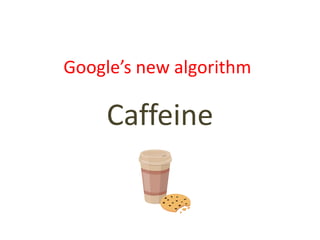
Google’S New Algorithm Caffeine
- 1. Google’s new algorithm Caffeine
- 2. What caffeine will focus on: Caffeine appears to put more emphasis on social media such as Facebook, My Space and blogs Even with the changes, most white hat optimization tactics will continue to prevail
- 3. Why did Google make this change? Project is supposed to revitalize the Google algorithm to provide users with a better search experience The official word is that the update is: "the first step in a process that will let us push the envelope on size, indexing speed, accuracy, comprehensiveness, and other dimensions."
- 4. What does it mean for SEO For search marketers, it means more competition for single, generic-type keywords, less stability of rankings, and an increased focus on long-tail keywords as they become more relevant to sales conversions.
- 5. Changes to expect from Caffeine Higher keyword density. Faster index. Most people report Caffeine queries are returned at faster speeds. Fresher results. Caffeine results are more current, including blog posts from the last few days. More emphasis on social media. Caffeine SERPs contain more sites like Facebook, LinkedIn, Blogger, etc. Less emphasis on universal search. While this is a popular feature and was also implemented by other search engines, it doesn't help Google's paid search revenue. Therefore, universal results will be moved lower on the page to make paid search more visible. Increased prominence of video. While news and image listings moved further down the page, Caffeine SERPs are prominently featuring video listings. Keywords in domain name. Google has always favored keywords in the domain name, and the new SERPs seem to weigh keyword domain names even higher. If you're launching a new site, a microsite with your keywords embedded within the URL might be wise.
- 6. What tactics to use? Create a site with clear hierarchy and text links. Create a site map with links to important pages. Create information-rich pages describing your content clearly and accurately. Use keywords in text. Give preference to text over images. Make <title> elements and ALT attributes descriptive and accurate. Check for broken links and correct HTML. Keep links on a given page to a reasonable number (<100). Avoid hidden text or hidden links. No cloaking or sneaky redirects. Don't load pages with irrelevant keywords. Don't create multiple pages, subdomains, or domains with duplicate content. Don't create pages with malicious behavior (phishing, viruses, trojans, badware).
